We Tried 5 Tricks for Peeling Eggs and Found a Clear Winner (No Matter How You Cooked Your Eggs)

We independently select these products—if you buy from one of our links, we may earn a commission.
With Easter right around the corner, many of us will find ourselves with pastel-hued hard-boiled eggs that we don’t want to go to waste. Ugh, but there’s the chore of peeling them. What can make that process easier?
We’ve shared our own three-step method to ensure your eggs are easier to peel, discussing all the front-end choices that can make the process painless. We’ve tested whether you should add baking soda to the cooking water and got mixed results. We’ve even tried seven different ways to cook hard-boiled eggs and noted how easy or difficult each one was to peel.
But what about testing the actual removal of the shell? We tried five different techniques from various website sources and learned a lot in the process. And yes, we actually did find one clear winner.
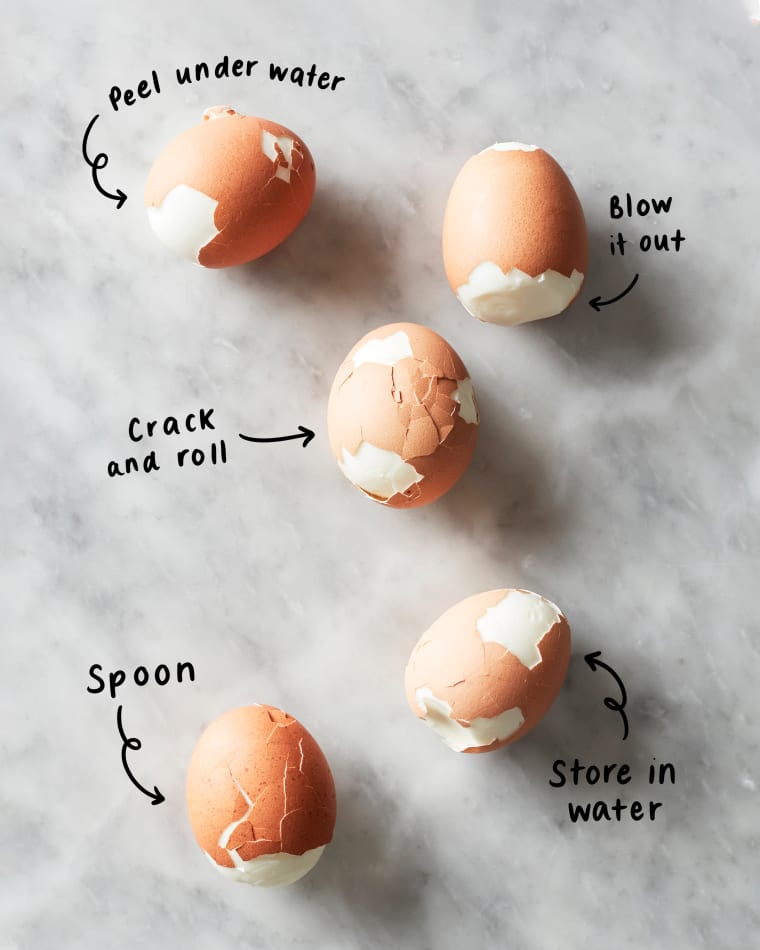

: Ghazalle Badiozamani; Food Styling: Brett Regot; Design: The Kitchn
How We Tested These Egg-Peeling Tricks
Eggs: For consistency, I purchased the same brand of large eggs (my favorite Vital Farms pasture-raised eggs) from one store, all with the same expiration date. They were all very fresh, which I knew should make peeling them more challenging (older eggs are typically easier to peel).
Boiling methods: I used two cooking methods to see if the eggs behaved differently. First, I steamed batches according to J. Kenji López-Alt’s method from the New York Times and let them naturally come to room temperature per the directions. Next, I boiled eggs using the “boil gently” method from Bon Appetit’s Healthyish and cooled them in an ice water bath before peeling.
Tests: I tried each method four times, with three eggs per time (so a total of a dozen eggs per method). I tested the steamed eggs and the boiled eggs shortly after cooking them, once they had cooled down per their instructions. Then, to try to replicate what most people would do at home after dying Easter eggs, I “aged” some eggs by letting them hang out in the fridge for a day and a half and then set about peeling them.
Time: The time I’ve listed is an average of my tests and represents how long it takes to peel one egg. It’s listed in seconds, rounding up or down to the nearest half-second. It includes everything involved — any prep you need to do, cracking the egg, and getting every bit of the shell off.
Ratings: I rated each method on a scale of one to 10, with 10 representing perfection. Factors that affected the ratings include ease of method, how well it removed the shell, and how fussy or messy the method was (or wasn’t).

Egg-Peeling Trick: Spoon
- Peeling time, recently cooked eggs: 22 seconds (steamed); 23 seconds (boiled)
- Peeling time, aged eggs: 22 seconds (steamed); 22 seconds (boiled)
- Rating: 4/10
About This Method: In a cool YouTube video titled “How to Peel an Egg in Under 10 Seconds,” the host demonstrates this technique. You start by tapping the wider base of the egg on the counter and peeling away about a quarter-sized spot of shell. You then insert the tip of a teaspoon into the opening, between the shell and egg, and rotate the spoon around the egg, working it down and around the egg until the shell comes off in one piece.
Results: First of all, it took longer than the 10 seconds the video touted. When you watch, you’ll see that it takes 10 seconds alone just to peel the quarter-sized spot of shell before you insert the spoon. But that’s OK, as 22 seconds is still pretty quick to peel an egg, and the timing was consistent for the recently cooked eggs and the aged eggs. The problem with this method is that with about half of the eggs, the spoon peeled away a layer of egg white as I moved it around the egg. Not only does this waste a bit of food, but it also makes for a pretty unattractive presentation.
My Takeaway: I’m just not sold on this method. About half of the time, it worked pretty well (meaning it didn’t cut into the egg), but it seemed like more fuss than it was worth — especially compared to the other methods I tested.
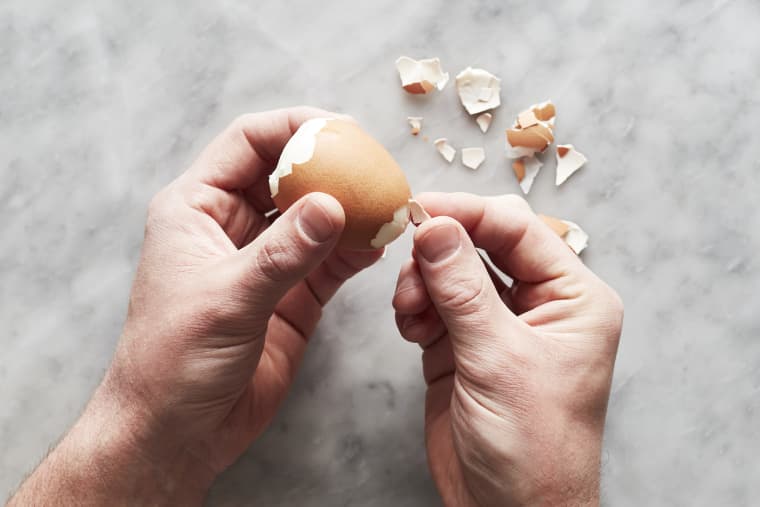
Egg-Peeling Trick: Blow It Out
- Peeling time, recently cooked eggs: 25.5 seconds (steamed); 29 seconds (boiled)
- Peeling time, aged eggs: 34.5 seconds (steamed); 29 seconds (boiled)
- Rating: 6/10
About This Method: For this “magic trick,” I followed the instructions in the same YouTube video that touted the spoon method. It starts with tapping the bottom end of the egg and removing a quarter-sized piece of shell, then tapping the top of the egg and peeling away a dime-sized piece of shell. You then hold your hand around the egg, bring it to your mouth, and blow hard until the egg pops out.
Results: As with the spoon method, this showy technique took longer than the 10 seconds the video promises; in the video, it takes about 12 seconds just to get the egg prepped. It did indeed work, with the egg popping out as shown after blowing really, really (seriously: really) hard. I sometimes had to blow on both sides of the egg to get it loose enough to pop out. With the aged eggs, it took considerably more effort; I thought I might pass out from blowing so hard.
My Takeaway: Sure, this is a fun party trick, and you’d better believe I’ll be showing it off to my nieces and nephews — there’s a hilarious loud whistling noise that happens as the egg gets loosened. But it’s just not practical for a batch of boiled eggs (remember how I almost passed out?). And you have to put your mouth on, or very near, the egg — and, well, blow on it. That’s just a little too much contact for food I’d be serving to other people.

Egg-Peeling Trick: Store in Water
- Peeling time, recently cooked eggs: 16.5 seconds (steamed); 16 seconds (boiled)
- Peeling time, aged eggs: 15.5 seconds (steamed); 16 seconds (boiled)
- Peeling time, aged eggs: 15.5 seconds (steamed); 16 seconds (boiled)
- Rating: 7/10
About This Method: WikiHow’s technique instructs you to completely submerge boiled eggs (cooled to room temperature) in cold water and refrigerate them for about one hour and up to three to four days before peeling them. The thinking is that “eggs peel easily when they are cold because the whites of the eggs constrict away from the shell.”
Results: The eggs did peel easily and cleanly, and there was no discernable difference between the performance of the recently cooked eggs and the aged eggs.
My Takeaway: If you are in no hurry and you have space for a container of water and eggs in your fridge, this method is fine. But as I would learn from testing the rest of these methods, the one-hour (or longer) soak isn’t really necessary. And for me, storing a water-filled bowl with eggs can be precarious. 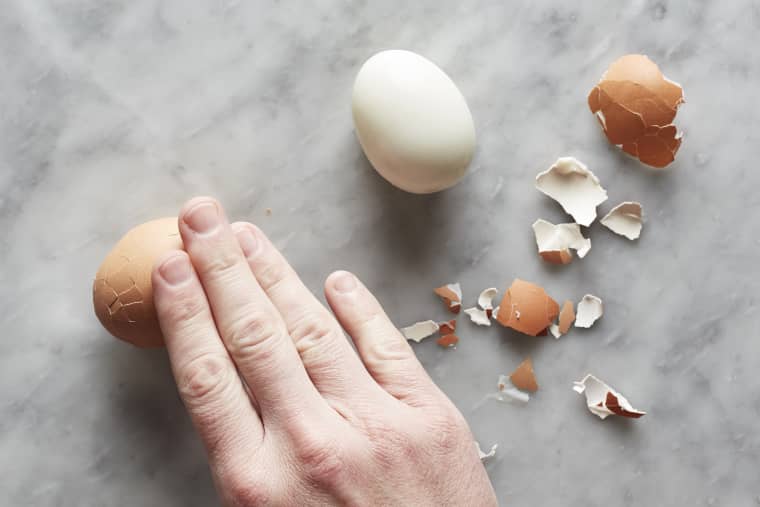

Egg-Peeling Trick: Crack and Roll
- Peeling time, recently cooked egg: 19.5 seconds (steamed); 22.5 seconds (boiled)
- Peeling time, aged eggs: 21.5 seconds (steamed); 19 seconds (boiled)
- Rating: 9/10
About This Method: I circled back to the YouTube video for the description and demonstration of this method. You tap the egg on the counter, then roll it across the surface while applying gentle pressure with your palm. This creates lots of little fractures over the shell, which you then peel off the egg.Results: I must confess that this has been my go-to method for peeling eggs for as long as I can remember. And for me, it works well every time. I always start peeling the egg from the wider bottom end (the video doesn’t specify this), where there’s usually an air pocket that allows an easy entry point. All those little cracks in the shell help pull the clingy membrane away so the shell comes off without you having to pick away at it.
My Takeaway: I like this method for its no-fuss ease. It requires nothing other than a countertop and your hands. It might take a little longer than some of the other methods, but only by a few seconds.
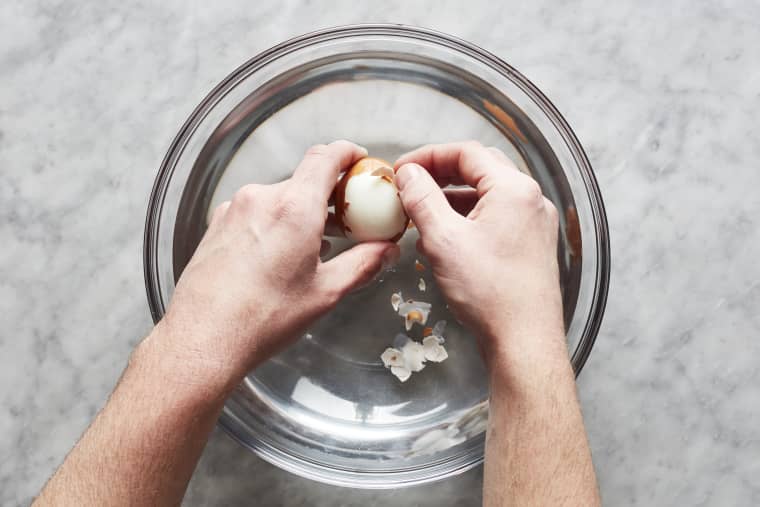
Egg-Peeling Trick: Peel Under Water
- Peeling time, recently cooked eggs: 13 seconds (steamed); 15 seconds (boiled)
- Peeling time, aged eggs: 16 seconds (steamed); 15 seconds (boiled)
- Rating: 10/10
About This Method: This technique from Food52 starts by filling a bowl (I used a medium-sized, fairly deep one) with room-temperature water. Working with one egg at a time, you submerge the egg under water in the bowl. You then crack it against the bottom or side of the bowl, and slip off the shell underwater.
Results: I was blown away by how well this method worked. The shells just slipped off with utmost ease each time, leaving shiny, smooth, perfectly peeled eggs. The article states that “once cracked, the water helps to gently separate both the membrane — that attaches itself with a vice-like grip to the egg — and the shell from the egg white, making it much easier to peel.” I am here to say that this is indeed true.
My Takeaway: Aside from the ease with which I peeled eggs using this method, there are two things I wanted to note. First, I feel like the properties at work here are similar to the magic that happens when you peel an egg under running water. But I don’t like to have water running — wasting it, in essence — as I work my way through each egg. This method makes do with a relatively small amount of water. Second, I often give my peeled eggs a quick rinse to remove any lingering fragments of shell and/or membrane, and this method eliminates the need for that. Each egg automatically gets a bath.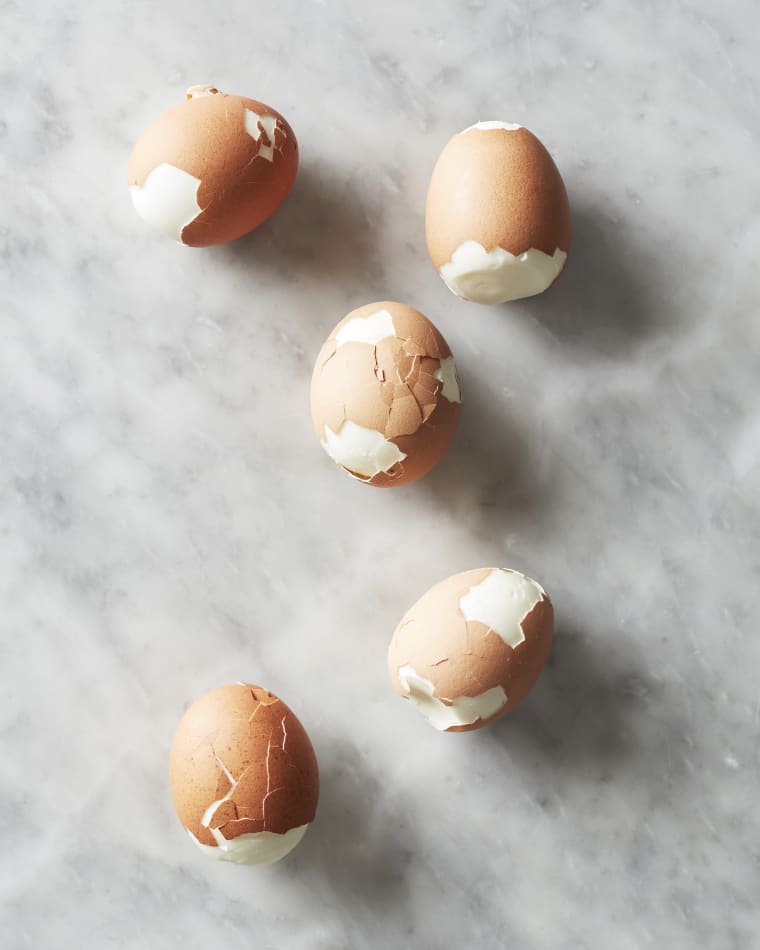

Final Thoughts
I’ll reserve the more showy techniques for party tricks because they’re just not practical for this busy cook. I’ll no doubt use my time-tested crack-and-roll technique for peeling one or two eggs, but when whipping up a big batch of deviled eggs — they’re one of my signature appetizers — I’ll always have a bowl of water ready.
No comments: